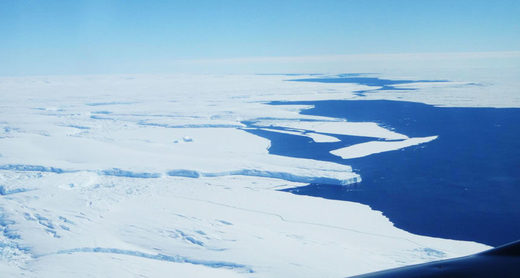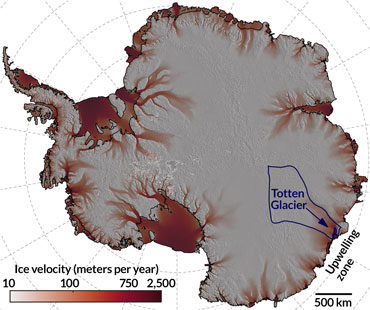
The wind is helping to awaken one of Antarctica's sleeping giants. Warm ocean waters, driven inland by winds, are undercutting an ice shelf that holds back a vast glacier from sliding into the ocean, researchers report November 1 in Science Advances.
Totten Glacier is East Antarctica's largest glacier, with a drainage basin encompassing about 550,000 square kilometers, an area about the size of France. Its floating front edge, the Totten ice shelf, sticks out like a tongue over the water and acts as a buttress for the giant glacier, slowing its movement toward the ocean. If the entire land-based glacier destabilizes and slips into the sea, it could raise global sea level by at least 3.5 meters.
Satellite and on-the-ground studies have previously shown that Totten Glacier and its buttressing ice shelf are thinning. Last year, scientists determined that the ice shelf is being melted from below by warm water. The ice shelf floats within a pool of its own cold meltwater that sits atop a deeper, saltier and warmer layer; the two layers generally don't mix, like oil and water. The warmer layer periodically rises up, becoming shallow enough to access grooves in the seafloor that extend beneath the ice shelf. But what controls the inflow of that warm water was unknown.
Wind is the likely culprit, geophysicist Chad Greene at the University of Texas at Austin and colleagues now report. The researchers examined nearly 14 years of satellite observations of the ice shelf, comparing 629 pairs of images to track how its position and size changed during that time. Then, the team used surface wind and sea ice measurements over that same time period to create an almanac of changes in wind direction and intensity. Those wind patterns influence the movement of the water, not just horizontally, but also vertically: By pushing a mass of water in one direction, more water wells up from below to fill the void.
When the researchers compared the timing of upwelling ocean water with ice shelf changes, they found a pattern. About 19 months after the wind churned the ocean, cycling cold deep waters upward and sending the warmer surface waters down, the Totten ice shelf was noticeably thinner and had sped up.
Surface winds near the East Antarctic coast are expected to intensify in the next century due to warming. As a result, the ice shelf is likely to both thin and flow faster, the researchers note - and eventually, that could allow the glacier to slide into the sea.
"We have little data on the ocean and ice shelf conditions in this region," says Fernando Paolo, a geophysicist at NASA's Jet Propulsion Laboratory in Pasadena, Calif. But the 14-year record used in the study is still somewhat short to infer a definitive link between wind-driven upwelling and ice shelf melt, he says. Still, he adds, these new data are a welcome addition to the pool of sparse observations, supporting the idea that Totten Glacier is very sensitive to changing oceanic conditions, much like the fast-thinning glaciers in West Antarctica.
Citations
C.A. Greene et al. Wind causes Totten Ice Shelf melt and acceleration. Science Advances. Published online November 1, 2017. doi: 10.1126/sciadv.1701681.
S.R. Rintoul et al. Ocean heat drives rapid basal melt of the Totten Ice Shelf. Science Advances. Published online December 16, 2016. doi: 10.1126/sciadv.1601610.
Further Reading
T. Sumner. Antarctic history suggests ice sheet 'danger' threshold. Science News. Vol. 189, April 2, 2016, p. 10.
D. Powell. Big Antarctic ice sheet appears doomed. Science News. Vol. 181, June 2, 2012, p. 5.




...back to you